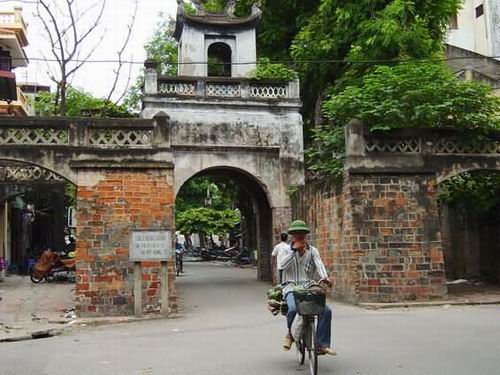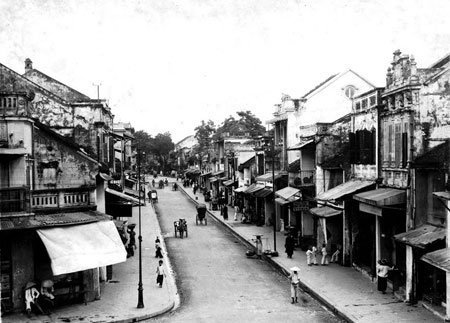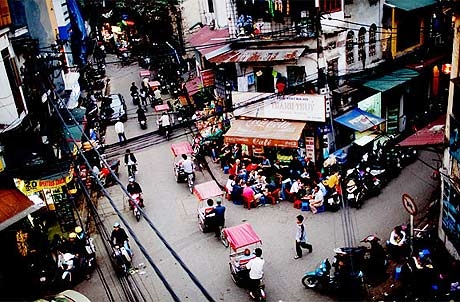the Hanoi’s Old Quarter is the soul of city, and the top special historical vestige and sight-seeing of the capital.
There’s an old Vietnamese saying, “Hanoi has thirty-six streets and guilds – Jam Street, Sugar Street, Salt Street…”. Inside a modern and dynamic city, there appears an antique quarter, the Hanoi’s Old Quarter – the represented eternal soul of the city. These days, most Vietnamese and Westerners are familiar with the phrase “Hà Nội - Ba mươi sáu phố phường” (translated as “Ha Noi - 36 districts” or “Hanoi – 36 Old Streets”), or “Phố cổ Hà Nội” (translated as “Hanoi’s Old Quarter”), the top special historical vestige and sight-seeing of the capital, luring international visitors thanks to their mostly original state.
 Hanoi 's old quarter
Hanoi 's old quarter
History of 36 streets old quarter
It would be a big surprise should you know that Hanoi's Old Quarter came into being at the time King Ly Thai To selected Thang Long as the country’s capital in 1010, that is, the streets have a nearly 1,000-year old history and became crowded & lively in 15th century. What makes them unique is that many of them remain in their very ancient architecture of the 15th century. Up to now, it has been the oldest continuously developed area of Vietnam.

Hanoi 's old quarter in the past
Due to their long-lasting age, they are called “Old Quarter” or “36 Old Streets” (as consisting of 36 member streets). Similarly to the Guilded age of Europe, “Ha Noi's 36 districts” is Vietnam's version of the guild concept. In the past, as artisans moved to the capital city to do business, they gathered together in this area to share the resources. As a result, many of the streets were named after the crafts sold at that individual street. Pho Hang Bun (Vermicelli), Pho Hang Ma (Paper Product), Pho Hang Bac (Silver), etc. are examples of the streets carrying the name of the products sold there.
The phrase “36 pho phuong” often causes much confusion for most people; “Phố” means a street or a place for merchants to gather to do business, while “Phường”, a district or a guild of artisans specializing in a particular trade (phuong cheo, phuong tho, etc.). Yet, in any case, both are right to some extent.
Although the old section of Hanoi is often called the "36 Old Streets," there are more than 36 actual streets. Some researchers believe that the number 36 came from the 15th century when there might have been 36 guild locations, which were workshop areas, not streets. When streets were later developed, the guild names were applied to the streets. Others attribute the 36 to a more abstract concept. The number nine in Asia represents the concept of "plenty." Nine times the four directions makes 36, which simply means "many". In fact, there are now more than 70 streets in the area.
Hanoi old quarter now
Exploring the maze of back streets is fascinating; some streets open up while others narrow down into a warren of smaller alleys. The area is known for its tunnel, or tube, houses – so called because their small frontages hide very long rooms. These tunnel houses were developed to avoid taxes based on the width of their frontage onto the street. By feudal law, houses were also limited to two storeys and, out of respect for the king, could not be taller than the Royal Palace. These days there are taller buildings (six to eight storeys high) but there are no real high rise buildings.
Some of the more specialized streets include Pho Hang Quat which has red candlesticks, funeral boxes, flags and other temple items; and Pho Hang Gai which is somewhat more glamorous with silk, embroidery, lacquer ware, paintings and water puppets – the silk sleeping bag liners and elegant Vietnamese ao dai are very popular with travellers. Finally, no trip to the Quarter would be complete without a trip to Dong Xuan market, on Pho Hong Khoi and Pho Dong Xuan, which was rebuilt after a 1994 fire.

A stroll through the historic Old Quarter can last anywhere from a few minutes to the better part of a day, depending on your pace and how well you navigate the increasing motor traffic plaguing the streets. However long, or whatever detours you might take, the following course will provide you with a good dose of Vietnamese culture, and some insight into the country’s long history.
A logical starting point is the Ngoc Son Temple in the northern end of Hoan Kiem Lake. After crossing back over the bright red Huc Bridge, stop for a quick look at the Martyrs’ Monument, erected to those who died in fighting for Vietnam’s independence. Head north on Pho Hang Dau past the Water Puppet Theatre (see the ‘Punch & Judy in a Pool’ boxed text in this chapter) and you’ll soon be surrounded by shoe shops selling every shape, size and style, demonstrating how serious Hanoians are about their footwear. Crossing over Pho Cau Go, pop into the colourful flower market which occupies the narrow eastern terminus of Pho Gia Nhu.
Back on Pho Hang Be; continue north to the ‘T’ intersection with Pho Hang Bac. Near here are several shops that carve intricate gravestones (most bearing an image of the deceased) by hand. A short detour north on Pho Ma May will lead you to the Memorial House at number 87 (see the main text entry earlier in this chapter), an exquisite Chinese merchant’s home that was recently restored and opened as a museum.

Return to Pho Hang Bac and head west past a strip of snazzy jewellery shops, then right onto Pho Hang Ngang past a row of clothing shops, and right again onto Pho Hang Buom; this will take you past the small Bach Ma Temple (White Horse Temple). As you pass the pagoda, with its red funeral palanquin, look for its white-bearded temple guards, who spend their days sipping tea. Legend has it that Ly King used the pagoda to pray for assistance in building the city walls because they persistently collapsed, no matter how many times he rebuilt them. His prayers were finally answered when a white horse appeared out of the temple and guided him to the site where he could safely build his walls. Evidence of his success is still visible at Cua O Quan Chuong, the quarter’s well-preserved Old East Gate at the eastern end of Pho Hang Chieu, near the intersection with Pho Tran Nhat Duat.
Head west, back along Pho Hang Chieu past a handful of shops selling straw mats and rope to reach one of the most interesting streets, Pho Hang Ma (literally ‘counterfeit street’), where imitation ‘ghost money’ is sold for burning in Buddhist ceremonies – it even has US$5000 bills! Loop around and follow your ears to the sounds of skilful blacksmiths pounding away on metal on the corner of Pho Lo Ren and Pho Thuoc Bac. Moving south on Pho Hang Duong, head right past the towel shops onto Pho Lan Ong, a fantastic row of herb sellers filling the street with succulent aromas.

Finally, head south past the tin box makers (opposite the mirror shops) on Pho Hang Thiec, then left toward the interesting shops selling Buddhist altars and statues along Pho Hang Quai. Time permitting, loop around and zigzag west over to check out the leather shops along Pho Ha Trung, working east again to end the tour at the superb, neo-Gothic St Joseph Cathedral (see the main text entry earlier in this chapter). If you’re feeling a bit knackered from the walk, a few steps from the church along Pho Nha Tho there is an alluring cluster of stylish restaurants and cafes.
Although many of the streets no longer sell the products after which they were named, some still do. Today, the Old Quarter has become the unique classical feature of Hanoi, and the inspiration of numerous writers, poets, and painters, and one of the desired tourist destinations in Hanoi.
If tourists in Vietnam Travel have chance to visit Hanoi, Temple of Literature is a must-see place that should not be missed!
www.vietnamtourism.org.vn
(84-63) 3 826042 – (84-63) 3 511142
No 54 Nguyen Dinh Chieu, Ham Tien Central Mui Ne Beach Binh Thuan Vietnam
523 To Hien Thanh District 10 Ho Chi Minh City Vietnam
Ha Long Halong City Quang Ninh Vietnam
A13 Hung Thong 2 Halong City Quang Ninh Vietnam




